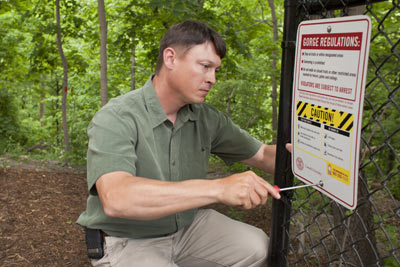New signs spell out regulations for safe gorge use
By Nancy Doolittle


Visitors to Cornell's gorges and waterways are now likely to encounter three new types of signs spelling out whether a particular area is highly dangerous.
The signs will provide regulations and general usage guidelines; permit limited access to specific areas, depending on conditions; or restrict access completely.
And for the first time, those who violate the regulations of the signs are subject to ticketing and arrest.
"The gorges are beautiful, but they are also dynamic and treacherous," said Todd Bittner, director of natural areas for Cornell Plantations. "We want students and the public to respect the gorges and safely use them for their enjoyment and long-term benefit."
The regulations are simple: Stay on trails or within designated areas; never swim anywhere in a gorge; and do not walk on closed trails or in other restricted areas marked by fences, gates and railings.
The gorges are especially inviting in late spring and summer months, but are also deceptively dangerous then, Bittner said, recalling the death of Kendrick Castro '11, who lost his life in a swimming accident in Fall Creek gorge almost exactly one year ago. Two other students also accidentally died in the gorges last summer, he said.
Bittner said that the shale formations of the gorges make them particularly unstable. Generally the rock behind the base of a waterfall is hollowed out, creating undertows in which even a strong swimmer can get pulled under and trapped; these pools are deceptively deep, and often have hazardous debris such as tree trunks and shopping carts. Shale is also brittle, making for weak cliff edges, falling rocks and trees, and hazardous trail surfaces. In the winter or springtime, especially, these hazards may necessitate the temporary closure of a section of the trail or natural area.
Other areas that are intrinsically dangerous year-round include the area behind the hydraulic electric plant because of its proximity to high voltage.
The new signs are part of an overall approach to gorge safety that includes four components: education in both the attractions and the dangers of Cornell's natural areas; enforcement of the regulations through increased patrolling and the possibility of arrest for violations; improvements in the infrastructure of the gorges and trails to enhance their safety; and the highlighting of alternatives for certain activities, such as swimming.
"By distinguishing between the levels of hazard that Cornell's gorges pose, we hope to encourage visitors to think about their own safety," Bittner said. "We have also developed new maps and a gorge brochure (PDF) to show safe places to hike, run, bike and swim. Our website will soon lead visitors to local waterfalls, miles of hiking and running trails, Plantations natural areas and gardens, and nearby state parks where swimming is allowed and lifeguards are on duty."
Media Contact
Get Cornell news delivered right to your inbox.
Subscribe